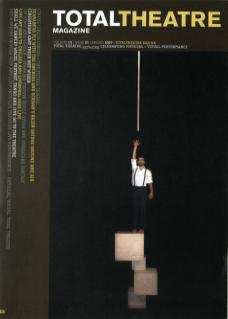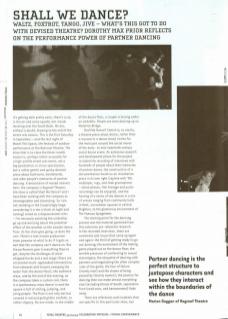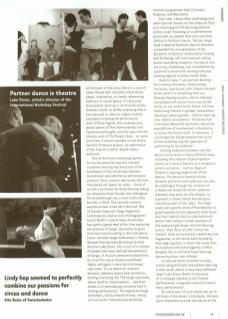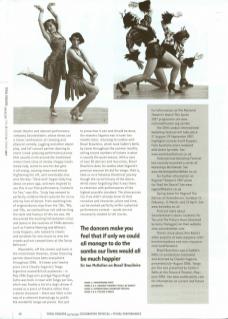It’s getting dark pretty early, there’s a nip in the air and some squally rain clouds hovering over the South Bank. We are, without a doubt, drawing to the end of the street arts season. This is the first Saturday in September – and the last night of Watch This Space, the festival of outdoor performance at the National Theatre. The show that is to close the three-month season is, perhaps rather unusually for a high-profile street arts event, not a big pyrotechnic or circus spectacular, but a rather gentle and quirky devised piece about ballrooms, bandstands, and older people’s memories of partner dancing. A declaration of vested interest here: the company is Ragroof Theatre, the show is called Shall We Dance? and I have been working with the company as choreographer and dramaturg. So I am not standing in the (surprisingly large, considering it is ten o’clock at night and raining) crowd as a dispassionate critic – I’m nervously watching the umbrellas go up and worrying about the potential effect of the weather on the wooden dance floor. As the show gets going, so does the rain. There’s a last minute production team powwow on what to do if it gets so wet that the company can’t dance on. But the performers give it everything they’ve got, despite the challenges of wind-whipped frocks and a wet stage (there are occasional much-applauded interventions from stewards with brooms sweeping the water from the dance floor); the audience stays, and by the end of the evening, as the company takes a curtain call, there is a spontaneous mass dance-in and the square is full of smiling, jumping, and jiving people. The floor is not only wet but covered in red and gold glitter confetti, so rather slippery. No one minds. In the middle of the dance floor, a couple is kissing under an umbrella. People are even dancing up on Waterloo Bridge.
Shall We Dance? (which is, to clarify, a theatre piece about dance, rather than a musical or a dance show) circles for the most part around the social mores of the early- to mid-twentieth century social dance scene. An extensive research and development phase for the project included the recording of interviews with hundreds of people about their memories of partner dance, the construction of a documentation booth as an installation piece in its own right (replete with ’30s wallpaper, rugs, and teak gramophone – where photos, film footage and audio recordings can be enjoyed), and the hosting of a series of tea dances in a mix of venues ranging from community halls in Kent, via outdoor squares in central Brighton, to the glamorous environment of The Famous Spiegeltent.
The starting point for the devising process was the material garnered from this extensive pre-rehearsal research. In the recorded interviews, there are comments and issues that come up again and again: the thrill of getting ready to go out dancing; the excitement of the mating game played out on the dance floor; the terrible pressures of conforming to sexual stereotypes; the etiquette of dancing with partners and negotiating the often complex rules of the game; the fear of failure (mostly men) and the shame of being passed by (mostly women); the passion for dancing that can make almost everything else (including threat of death, separation from loved ones, and bereavement) fade away.
There are references and incidents that are specific to this particular show, but at the heart of the piece there is a core of ideas shared with countless other shows about, inspired by, or simply referencing ballroom or social dance. It’s basically that partner dancing is intrinsically pretty dramatic stuff, so hardly surprising that it has recurred so often as subject matter: examples including the performance work of Rose English, the contemporary dance pieces of The Cholmondeleys and Featherstonehaughs, and the experimental theatre work of The People Show – to name but a few. A recent example is Fran Barbe Dance’s Chimaera project, an exploration of the foxtrot in which ‘butoh meets ballroom’.
One of the most interesting aspects for me has been the way this interest in partner dancing has been part of the breakdown of the old divides between mainstream and alternative performance practice. Once, partner dance was the love that dared not speak its name – those of us with a penchant for Dirty Dancing hiding our obsession from friends and colleagues. The breakthrough was a slow trickle that became a flood. One seminal moment was the arrival in the UK in the mid-’80s of Claudio Segovia’s Tango Argentino. Contemporary dancer and choreographer Laurie Booth is one of many artists who has spent a great deal of his time exploring the essence of tango, deconstructing its form and reconstructing it into new dance forms. Another tango enthusiast is Theatre Nomad/International Workshop Festival director Luke Dixon, who is one of a number of people who have realised the potential of tango, in its pure unreconstructed form, as a tool for use in theatre workshops: ‘Again and again I come back to tango,’ says Luke. ‘It is a dance of constant dynamic, between desire and resistance, leading and being led. The tango especially opens itself to improvisation… and that makes it a tremendously versatile tool in making performance.’ The Argentine tango workshops, led by Andreas Knoop, always sell out at the International Workshop Festival programmes held in London, Brighton, and Barcelona.
Like Luke, I have often used tango and other partner dances on the rehearsal floor as a starting point for devising physical action, even if working on a performance piece with no content that even remotely relates to ballroom dance. The key tango (and indeed all ballroom dance) elements are perfect for an exploration of the dynamics of physical relationship: leading and following; call and response; taking action and being receptive; moving as one; mirroring, shadowing, and complementing a partner’s movement; working with and working against another human body.
Back to Luke: ‘I use partner dancing for creating character, relationships, narrative, and drama. With Theatre Nomad we’ve used it in everything from our Faraway Nearby project, which collected and played with stories from around the world, to our recent Uncle Vanya. We have had a long interest in gender, and partner dancing is about gender… Partner dancing also implies an audience. The dance hall is as much about the spectator, about the possibilities of involvement in the dance, as about the dance itself. In rehearsal, it can bridge the divide between the circle of the workshop and the openness of performing to an audience.’
Inviting audience members into the dance can be done in many different ways, including the creation of participation events as a central feature of a company’s artistic activities – such as Ragroof Theatre’s ongoing programme of tea dances. The physical/spatial divide between performer and audience can also be challenged through the creation of a theatrical world into which audiencemembers may enter as role-players, to a greater or lesser extent becoming an interactive part of the ‘play’. The large-scale site-specific work of Punchdrunk is a good example of this approach: both Faust and The Firebird’s Ball include ballroom/ dance-hall scenes in which members of the audience get drawn into the dancing action. Then there are the ‘immersive theatre’ total environments created by Lost Vagueness, or the lavish balls hosted by Miss High Leg Kick, in which the lovely Miss Kick partners the extravagantly coiffed Boogalu Stu in a Strictly Come Dancing deconstruction-cum-tribute.
So why are there currently so many artists using ballroom and partner dancing in their work, albeit in very many different ways? Luke Dixon thinks it’s because of ‘a renewed interest in skill-based performance, in popular culture(s) and in retro-performance’.
An artist who I’m sure would own up to all three of the above is Aila Baila. She and Dave Chameleon are the two halves of the street theatre and cabaret performance company Swizzleshaker, whose shows use a clever combination of clowning and physical comedy, juggling and other object play, and (of course) partner dancing to enact crowd-pleasing performance pieces that usually circle around the traditional mime/clown story of cheeky chappy meets lovely lady, wants to woo her but gets it all wrong, causing chaos and almost frightening her off, until eventually love wins the day: ‘Dave and I began lindy hop about six years ago, and were inspired to use this in our first performance, Cocktails for Two,’ says Aila. ‘Lindy hop seemed to perfectly combine Dave’s passion for circus and my love of dance. From watching lots of original dance clips from the ’30s, ’40s, and ’50s, we realised how rich and exciting the style and humour of this era was. We discovered the exciting link between circus and dance in the routines of 1940s dancers such as Frankie Manning and Whitey’s Lindy Hoppers, who looked to clowns and acrobats for new moves to wow the crowds and win competitions at the Savoy Ballroom.’
Meanwhile, off the streets and back in the mainstream theatres, shows featuring partner dance have been everywhere throughout 2006. It’s been over twenty years since Claudio Segovia’s Tango Argentino wowed British audiences – in May 2006 Segovia’s protégé Miguel Angel Zotto was back in town with Tango por Dos, which was frankly a bit of a dog’s dinner if viewed as a piece of theatre rather than a dance showcase – there was little in the way of a coherent dramaturgy to justify the wonderful tango set pieces. But just to prove how it can and should be done, the maestro Segovia was in town two months later, returning to London with Brasil Brasileiro, which took Sadler’s Wells by storm throughout the summer months, selling record numbers of tickets in what is usually the quiet season. With a cast of over 50 dancers and musicians, Brasil Brasileiro does for samba what Segovia’s previous massive hit did for tango: that is, take us on a fabulous theatrical journey though the social history of the dance, whilst never forgetting that it was there to entertain with performances of the highest possible standard. The show proves (as if we didn’t already know it) that narrative and character, place and time, can be evoked perfectly within a physical performance context – words are not necessarily needed to tell stories.
For information on The National Theatre’s Watch This Space 2007 programme see www. nationaltheatre.org.uk/wts
The 20th London International Workshop Festival will take place 27 August–29 September 2007. Highlights include Snuff Puppets from Australia and a weekend with Annie Sprinkle. See www. workshopfestival.co.uk
International Workshop Festival has recently launched a series of Workshops Worldwide: See www. WorkshopsWorldWide.co.uk
For further information on Ragroof Theatre’s 2007 plans for Shall We Dance? See www. ragrooftheatre.co.uk
Spring dates for Ragroof Tea Dances at Komedia are: Sundays 11 February, 11 March, and 15 April. See www.komedia.co.uk
Find out more about Swizzleshaker’s shows Cocktails for Two and The Picture Show (directed by Gerry Flanagan) on their website www.swizzleshaker.com
There’s more about Aila Baila’s other projects at www.myspace.com/ beeskneesplease and www.myspace. com/aireflamenco
Brasil Brasileiro was a Sadler’s Wells co-production conceived and directed by Claudio Segovia, presented July–August 2006. Tango por Dos was presented by Sadler’s Wells at the Peacock Theatre, May– June 2006. See www.sadlerswells.com for information on current and future projects.



